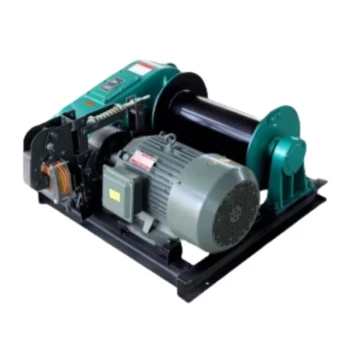Trailer winches are rated primarily based on their weight capacity, which determines their ability to safely pull and secure loads like boats, equipment, or other heavy items. The rating reflects the maximum load the winch can handle, ensuring safe operation without mechanical failure. Choosing the right winch involves matching its capacity to the total weight of your load, including any additional gear or accessories.
Key Points Explained:
-
Weight Capacity as Primary Rating
- The core rating of a trailer winch is its maximum load capacity, measured in pounds (lbs) or kilograms (kg).
- Example: A 3,000-lb winch is designed to handle loads up to that weight, including the boat, motor, fuel, and gear.
- Why it matters: Exceeding this capacity risks winch failure, cable snapping, or trailer instability.
-
Factors Influencing Winch Selection
- Total Load Weight: Sum of the boat, motor, and equipment (e.g., anchors, batteries).
- Cable Length: Longer boats may need extended cables to reach the bow eye from the winch post.
- Gear Ratio: Higher ratios (e.g., 4:1) provide more pulling power for heavier loads but require more cranking.
-
Matching Winch to Application
- Light-duty (1,000–2,000 lbs): Small boats or jet skis.
- Medium-duty (3,000–5,000 lbs): Mid-sized fishing boats.
- Heavy-duty (6,000+ lbs): Large vessels or commercial trailers.
- Pro Tip: Always choose a winch with a capacity at least 20% higher than your calculated load for safety margins.
-
Additional Features to Consider
- Automatic Braking: Prevents uncontrolled unwinding.
- Strap vs. Cable: Steel cables are durable but heavier; synthetic straps are lighter but may degrade in UV light.
- Mounting Style: Fixed vs. swivel bases for flexibility.
-
Safety and Maintenance
- Regularly inspect cables/straps for fraying or corrosion.
- Lubricate gears and mechanisms to ensure smooth operation.
Ever wondered why some winches have dual-speed modes? High speed for light loads and low speed for heavy pulls can save time and effort.
By understanding these ratings and features, you can select a winch that combines power, durability, and safety—ensuring your load stays secure from launch to retrieval.
Summary Table:
| Key Factor | Description |
|---|---|
| Weight Capacity | Maximum load the winch can handle (e.g., 3,000 lbs for mid-sized boats). |
| Total Load Weight | Includes boat, motor, fuel, and accessories—choose a winch 20% above this. |
| Cable Length | Longer cables needed for larger boats to reach the bow eye. |
| Gear Ratio | Higher ratios (4:1) offer more power but require more cranking effort. |
| Duty Level | Light (1K–2K lbs), Medium (3K–5K lbs), Heavy (6K+ lbs) for different boat sizes. |
| Safety Features | Automatic braking, corrosion-resistant cables, and UV-resistant straps. |
Need a durable winch for your trailer? Contact us to explore Garlway’s heavy-duty winches and construction machinery designed for reliability and performance.
Related Products
- Best 18000 Pound Drum Anchor Trailer Winch
- Warn Winch Windlass Boat Trailer Winch
- 12000 lb Electric Boat Trailer Winch with Windlass Anchor Warn
- Electric and Hydraulic Winch for Heavy Duty Applications
- Quick Windlass Portable Winch for Truck and Boat Best Boat Winch
People Also Ask
- What is a trailer winch used for? Essential Tool for Safe and Efficient Load Handling
- What is the primary function of trailer winches? Essential Tools for Safe Cargo Loading
- How does the cable system work in trailer winches? A Complete Guide to Load Management
- How does using a trailer mounted winch reduce the need for additional equipment? Streamline Your Operations
- What is the purpose of a trailer winch? Essential Tool for Heavy Load Handling








